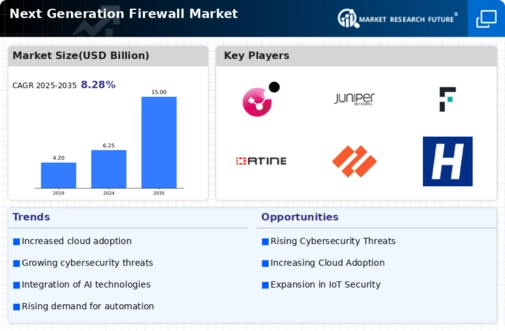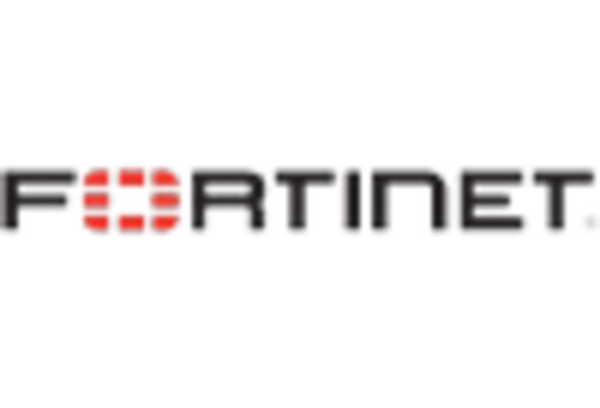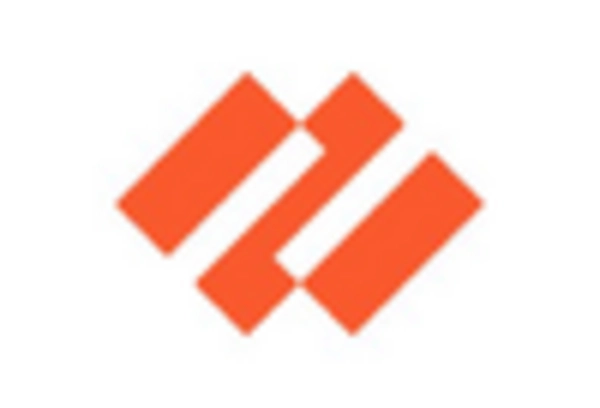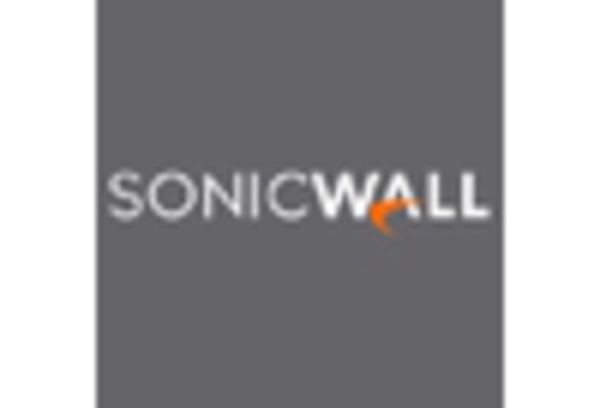Rising Cybersecurity Threats
The increasing frequency and sophistication of cyber threats is a primary driver for the Next Generation Firewall Market. Organizations are facing a myriad of attacks, including ransomware, phishing, and advanced persistent threats. As a result, the demand for robust security solutions has surged. According to recent data, the cybersecurity market is projected to reach USD 345 billion by 2026, indicating a strong need for advanced firewalls that can adapt to evolving threats. Next generation firewalls offer enhanced capabilities such as deep packet inspection and intrusion prevention, which are essential for mitigating these risks. This trend underscores the necessity for businesses to invest in advanced security measures, thereby propelling the growth of the Next Generation Firewall Market.
Increased Adoption of Remote Work
The shift towards remote work has significantly influenced the Next Generation Firewall Market. As organizations embrace flexible work arrangements, the need for secure remote access has become paramount. This transition has led to a rise in the deployment of next generation firewalls that can provide secure connections for remote employees. Data suggests that the remote workforce is expected to remain at elevated levels, with approximately 30% of employees working remotely by 2026. Consequently, businesses are prioritizing the implementation of advanced firewall solutions to protect sensitive data and maintain compliance with security protocols. This trend is likely to drive the demand for next generation firewalls, as organizations seek to safeguard their networks against potential vulnerabilities associated with remote work.
Regulatory Compliance Requirements
The evolving landscape of regulatory compliance is a significant factor driving the Next Generation Firewall Market. Organizations are increasingly required to adhere to stringent regulations such as GDPR, HIPAA, and PCI DSS, which mandate robust data protection measures. Non-compliance can result in severe penalties, prompting businesses to invest in advanced security solutions. The market for compliance-related cybersecurity solutions is projected to grow substantially, with estimates indicating a compound annual growth rate of over 20% in the coming years. Next generation firewalls play a crucial role in helping organizations meet these compliance requirements by providing features such as logging, monitoring, and reporting capabilities. This necessity for compliance is likely to bolster the growth of the Next Generation Firewall Market.
Integration of Advanced Technologies
The integration of advanced technologies such as artificial intelligence and machine learning is transforming the Next Generation Firewall Market. These technologies enhance the capabilities of firewalls, enabling them to analyze vast amounts of data and identify threats in real-time. The market for AI-driven cybersecurity solutions is expected to witness substantial growth, with projections indicating a value of USD 46 billion by 2027. Next generation firewalls equipped with AI and machine learning can adapt to new threats more effectively, providing organizations with a proactive defense mechanism. This technological advancement not only improves security posture but also streamlines operations, making it a compelling driver for the Next Generation Firewall Market.
Growing Demand for Unified Security Solutions
The demand for unified security solutions is increasingly shaping the Next Generation Firewall Market. Organizations are seeking integrated security platforms that can consolidate various security functions, such as firewall, intrusion detection, and threat intelligence, into a single solution. This trend is driven by the need for simplified management and enhanced visibility across security infrastructures. Market analysis indicates that the unified threat management segment is expected to grow at a compound annual growth rate of over 15% through 2025. Next generation firewalls that offer unified security capabilities are well-positioned to meet this demand, providing organizations with comprehensive protection against diverse threats. This shift towards unified solutions is likely to propel the growth of the Next Generation Firewall Market.


















Leave a Comment